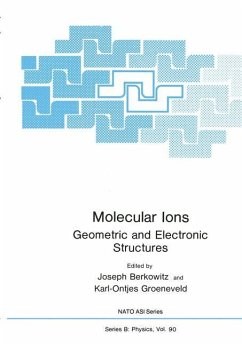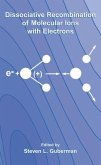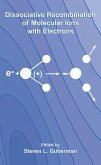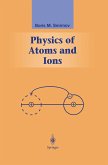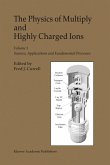- Broschiertes Buch
- Merkliste
- Auf die Merkliste
- Bewerten Bewerten
- Teilen
- Produkt teilen
- Produkterinnerung
- Produkterinnerung
The present volume contains contributions presented at the NATO Advanced Study Institute on Molecular Ions held on the island of Kos, Greece, from September 30 to October 10, 1980. The meeting was attended by some 60 participants from 15 different countries. It was the first meeting devoted exclusively to the topic of molecular ions. Its vitality derived from bringing together experts and students from a wide variety of disciplines, whose studies bear upon the structure of molecular ions. The aim of the meeting was to assemble these scientists, representing many countries in Europe and North…mehr
Andere Kunden interessierten sich auch für
![Molecular Ions Molecular Ions]() Joseph BerkowitzMolecular Ions104,99 €
Joseph BerkowitzMolecular Ions104,99 €![Dissociative Recombination of Molecular Ions with Electrons Dissociative Recombination of Molecular Ions with Electrons]() Dissociative Recombination of Molecular Ions with Electrons116,99 €
Dissociative Recombination of Molecular Ions with Electrons116,99 €![Dissociative Recombination of Molecular Ions with Electrons Dissociative Recombination of Molecular Ions with Electrons]() Steven L. Guberman (Hrsg.)Dissociative Recombination of Molecular Ions with Electrons117,99 €
Steven L. Guberman (Hrsg.)Dissociative Recombination of Molecular Ions with Electrons117,99 €![Physics of Atoms and Ions Physics of Atoms and Ions]() Boris M. SmirnovPhysics of Atoms and Ions38,99 €
Boris M. SmirnovPhysics of Atoms and Ions38,99 €![Physics of Highly Charged Ions Physics of Highly Charged Ions]() R. K. JanevPhysics of Highly Charged Ions39,99 €
R. K. JanevPhysics of Highly Charged Ions39,99 €![The Physics of Multiply and Highly Charged Ions The Physics of Multiply and Highly Charged Ions]() F.J. Currell (Hrsg.)The Physics of Multiply and Highly Charged Ions181,99 €
F.J. Currell (Hrsg.)The Physics of Multiply and Highly Charged Ions181,99 €![Physics of Highly Excited Atoms and Ions Physics of Highly Excited Atoms and Ions]() Vladimir S. LebedevPhysics of Highly Excited Atoms and Ions74,99 €
Vladimir S. LebedevPhysics of Highly Excited Atoms and Ions74,99 €-
-
-
The present volume contains contributions presented at the NATO Advanced Study Institute on Molecular Ions held on the island of Kos, Greece, from September 30 to October 10, 1980. The meeting was attended by some 60 participants from 15 different countries. It was the first meeting devoted exclusively to the topic of molecular ions. Its vitality derived from bringing together experts and students from a wide variety of disciplines, whose studies bear upon the structure of molecular ions. The aim of the meeting was to assemble these scientists, representing many countries in Europe and North America, to discuss the advances and capabilities of the various experimental and theoretical approaches and to point out un solved problems and directions for future research. The format, in volving lecturers and students, served as a tutorial. Molecular ions play an important role in very diverse fields of nature such as reactions in the ionosphere, the processes of forma tion of molecules in dense interstellar clouds, and the magnetohydro dynamics of plasmas used for energy generation. Our understanding of the properties of molecular ions, their electronic and geometric structures, has been developing from a variety of sources, as far removed as tickling ions with radiofre quency radiation and smashing them apart at relativistic energies. Various laser techniques are described, and the queen of structural determination, spectroscopy, is well represented. On the instrumen tal side, older techniques have been perfected and new methods have evolved.
Produktdetails
- Produktdetails
- Nato ASI Subseries B 91
- Verlag: Springer US / Springer, Berlin
- Softcover reprint of the original 1st ed. 1983
- Seitenzahl: 612
- Erscheinungstermin: 4. November 2011
- Englisch
- Abmessung: 244mm x 170mm x 33mm
- Gewicht: 1076g
- ISBN-13: 9781461336662
- ISBN-10: 146133666X
- Artikelnr.: 39498242
- Nato ASI Subseries B 91
- Verlag: Springer US / Springer, Berlin
- Softcover reprint of the original 1st ed. 1983
- Seitenzahl: 612
- Erscheinungstermin: 4. November 2011
- Englisch
- Abmessung: 244mm x 170mm x 33mm
- Gewicht: 1076g
- ISBN-13: 9781461336662
- ISBN-10: 146133666X
- Artikelnr.: 39498242
I. Introductory Presentation.- Spectroscopy of Molecular Ions - A Historical Survey.- II. Microwave and Laser Spectroscopy of Molecular Ions.- Microwave Studies of Molecular Ions.- Fast-Beam Laser Spectroscopy of Molecular Ions.- Vibration-Rotation Spectroscopy of the HD+ Ion.- Structure of Molecular Ions from Laser Magnetic Resonance Spectroscopy.- Laser-Induced Fluorescence of Trapped Molecular Ions.- III. Spectroscopies of Molecular Ions ((IR, Visible, UV, and Photoelectron)).- Determination of Molecular Ion Structures by Photoelectron Spectroscopy.- Gas-Phase Structure Studies of Open-Shell Organic Cations by Means of their Radiative Decay.- Infrared Absorption Spectra of Molecular Ions in Solid Argon.- Visible and Ultraviolet Spectra and Photochemistry of Molecular Ions in Solid Argon.- Contributed Papers.- Application of Data from Photoelectron Spectroscopy to Optical Spectroscopic Studies of Gaseous Cations.- Role of Core Hole State Geometry in Molecular Electron Spectroscopies.- Electronic Fluorescence Spectra of Gas-Phase Positive Ions.- HeI Photoelectron Spectroscopy of Transient and Unstable Species.- Autoionization Processes in Carbonyl Sulfide Investigated by Threshold Photoelectron Spectroscopy.- Correlation and Self-Repulsion in Studies of Molecular Ions with the HAM Method.- IV. Molecular Ion Structures By Ab Initio Theory.- Theoretical Studies of the Structures of Molecular Ions.- MRD-CI Method for the Study of Low-Lying Electronic States. Application to Second-Row Molecular Ions of Type AH2+, AH+, AB+, and HAB+.- Green's Function Calculations of Ionization Spectra of Molecules in the Outer and Inner Valence Region.- Contributed Papers.- Calculations of Electric Dipole Transition Probabilities in the Electronic Ground States of the NeH+, ArH+, andKrH+ Ions.- Ab Initio Potential Energy Functions and Vibrational States of the Fluoronium and Chloronium Ions.- Ab Initio Calculation of Potential Energy Curves of the CO2+ Ion.- Density Functional Approach to Molecular Structure and Atomic Scattering.- V. Structural and Related Studies Using MeV Molecular Ions.- Geometric and Electronic Structures of Molecular Ions from High Energy Collisions.- Geometric and Electronic Structure of Molecular Ions Penetrating through Solids.- The Role of Excited States of Molecular Ions in Structure Studies with High Energy Collisions.- VI. Other Studies of Molecular Ion Properties.- A Proposed Mechanism for Forming Some Larger Molecules in Dense Interstellar Clouds.- Contributed Papers.- Comparative Study of the Reactivity of Gaseous Ions in Selected Internal Energy States by Using a Tandem and a Triple Mass Spectrometer.- Ligand Field Aspects of the Electronic Structure of Molecular Ions of Metal Coordination Compounds.- Surface Interactions between a Water Molecule and a Ferroelectric Crystal of NaNO2.
I. Introductory Presentation.- Spectroscopy of Molecular Ions - A Historical Survey.- II. Microwave and Laser Spectroscopy of Molecular Ions.- Microwave Studies of Molecular Ions.- Fast-Beam Laser Spectroscopy of Molecular Ions.- Vibration-Rotation Spectroscopy of the HD+ Ion.- Structure of Molecular Ions from Laser Magnetic Resonance Spectroscopy.- Laser-Induced Fluorescence of Trapped Molecular Ions.- III. Spectroscopies of Molecular Ions ((IR, Visible, UV, and Photoelectron)).- Determination of Molecular Ion Structures by Photoelectron Spectroscopy.- Gas-Phase Structure Studies of Open-Shell Organic Cations by Means of their Radiative Decay.- Infrared Absorption Spectra of Molecular Ions in Solid Argon.- Visible and Ultraviolet Spectra and Photochemistry of Molecular Ions in Solid Argon.- Contributed Papers.- Application of Data from Photoelectron Spectroscopy to Optical Spectroscopic Studies of Gaseous Cations.- Role of Core Hole State Geometry in Molecular Electron Spectroscopies.- Electronic Fluorescence Spectra of Gas-Phase Positive Ions.- HeI Photoelectron Spectroscopy of Transient and Unstable Species.- Autoionization Processes in Carbonyl Sulfide Investigated by Threshold Photoelectron Spectroscopy.- Correlation and Self-Repulsion in Studies of Molecular Ions with the HAM Method.- IV. Molecular Ion Structures By Ab Initio Theory.- Theoretical Studies of the Structures of Molecular Ions.- MRD-CI Method for the Study of Low-Lying Electronic States. Application to Second-Row Molecular Ions of Type AH2+, AH+, AB+, and HAB+.- Green s Function Calculations of Ionization Spectra of Molecules in the Outer and Inner Valence Region.- Contributed Papers.- Calculations of Electric Dipole Transition Probabilities in the Electronic Ground States of the NeH+, ArH+, and KrH+ Ions.- Ab Initio Potential Energy Functions and Vibrational States of the Fluoronium and Chloronium Ions.- Ab Initio Calculation of Potential Energy Curves of the CO2+ Ion.- Density Functional Approach to Molecular Structure and Atomic Scattering.- V. Structural and Related Studies Using MeV Molecular Ions.- Geometric and Electronic Structures of Molecular Ions from High Energy Collisions.- Geometric and Electronic Structure of Molecular Ions Penetrating through Solids.- The Role of Excited States of Molecular Ions in Structure Studies with High Energy Collisions.- VI. Other Studies of Molecular Ion Properties.- A Proposed Mechanism for Forming Some Larger Molecules in Dense Interstellar Clouds.- Contributed Papers.- Comparative Study of the Reactivity of Gaseous Ions in Selected Internal Energy States by Using a Tandem and a Triple Mass Spectrometer.- Ligand Field Aspects of the Electronic Structure of Molecular Ions of Metal Coordination Compounds.- Surface Interactions between a Water Molecule and a Ferroelectric Crystal of NaNO2.
I. Introductory Presentation.- Spectroscopy of Molecular Ions - A Historical Survey.- II. Microwave and Laser Spectroscopy of Molecular Ions.- Microwave Studies of Molecular Ions.- Fast-Beam Laser Spectroscopy of Molecular Ions.- Vibration-Rotation Spectroscopy of the HD+ Ion.- Structure of Molecular Ions from Laser Magnetic Resonance Spectroscopy.- Laser-Induced Fluorescence of Trapped Molecular Ions.- III. Spectroscopies of Molecular Ions ((IR, Visible, UV, and Photoelectron)).- Determination of Molecular Ion Structures by Photoelectron Spectroscopy.- Gas-Phase Structure Studies of Open-Shell Organic Cations by Means of their Radiative Decay.- Infrared Absorption Spectra of Molecular Ions in Solid Argon.- Visible and Ultraviolet Spectra and Photochemistry of Molecular Ions in Solid Argon.- Contributed Papers.- Application of Data from Photoelectron Spectroscopy to Optical Spectroscopic Studies of Gaseous Cations.- Role of Core Hole State Geometry in Molecular Electron Spectroscopies.- Electronic Fluorescence Spectra of Gas-Phase Positive Ions.- HeI Photoelectron Spectroscopy of Transient and Unstable Species.- Autoionization Processes in Carbonyl Sulfide Investigated by Threshold Photoelectron Spectroscopy.- Correlation and Self-Repulsion in Studies of Molecular Ions with the HAM Method.- IV. Molecular Ion Structures By Ab Initio Theory.- Theoretical Studies of the Structures of Molecular Ions.- MRD-CI Method for the Study of Low-Lying Electronic States. Application to Second-Row Molecular Ions of Type AH2+, AH+, AB+, and HAB+.- Green's Function Calculations of Ionization Spectra of Molecules in the Outer and Inner Valence Region.- Contributed Papers.- Calculations of Electric Dipole Transition Probabilities in the Electronic Ground States of the NeH+, ArH+, andKrH+ Ions.- Ab Initio Potential Energy Functions and Vibrational States of the Fluoronium and Chloronium Ions.- Ab Initio Calculation of Potential Energy Curves of the CO2+ Ion.- Density Functional Approach to Molecular Structure and Atomic Scattering.- V. Structural and Related Studies Using MeV Molecular Ions.- Geometric and Electronic Structures of Molecular Ions from High Energy Collisions.- Geometric and Electronic Structure of Molecular Ions Penetrating through Solids.- The Role of Excited States of Molecular Ions in Structure Studies with High Energy Collisions.- VI. Other Studies of Molecular Ion Properties.- A Proposed Mechanism for Forming Some Larger Molecules in Dense Interstellar Clouds.- Contributed Papers.- Comparative Study of the Reactivity of Gaseous Ions in Selected Internal Energy States by Using a Tandem and a Triple Mass Spectrometer.- Ligand Field Aspects of the Electronic Structure of Molecular Ions of Metal Coordination Compounds.- Surface Interactions between a Water Molecule and a Ferroelectric Crystal of NaNO2.
I. Introductory Presentation.- Spectroscopy of Molecular Ions - A Historical Survey.- II. Microwave and Laser Spectroscopy of Molecular Ions.- Microwave Studies of Molecular Ions.- Fast-Beam Laser Spectroscopy of Molecular Ions.- Vibration-Rotation Spectroscopy of the HD+ Ion.- Structure of Molecular Ions from Laser Magnetic Resonance Spectroscopy.- Laser-Induced Fluorescence of Trapped Molecular Ions.- III. Spectroscopies of Molecular Ions ((IR, Visible, UV, and Photoelectron)).- Determination of Molecular Ion Structures by Photoelectron Spectroscopy.- Gas-Phase Structure Studies of Open-Shell Organic Cations by Means of their Radiative Decay.- Infrared Absorption Spectra of Molecular Ions in Solid Argon.- Visible and Ultraviolet Spectra and Photochemistry of Molecular Ions in Solid Argon.- Contributed Papers.- Application of Data from Photoelectron Spectroscopy to Optical Spectroscopic Studies of Gaseous Cations.- Role of Core Hole State Geometry in Molecular Electron Spectroscopies.- Electronic Fluorescence Spectra of Gas-Phase Positive Ions.- HeI Photoelectron Spectroscopy of Transient and Unstable Species.- Autoionization Processes in Carbonyl Sulfide Investigated by Threshold Photoelectron Spectroscopy.- Correlation and Self-Repulsion in Studies of Molecular Ions with the HAM Method.- IV. Molecular Ion Structures By Ab Initio Theory.- Theoretical Studies of the Structures of Molecular Ions.- MRD-CI Method for the Study of Low-Lying Electronic States. Application to Second-Row Molecular Ions of Type AH2+, AH+, AB+, and HAB+.- Green s Function Calculations of Ionization Spectra of Molecules in the Outer and Inner Valence Region.- Contributed Papers.- Calculations of Electric Dipole Transition Probabilities in the Electronic Ground States of the NeH+, ArH+, and KrH+ Ions.- Ab Initio Potential Energy Functions and Vibrational States of the Fluoronium and Chloronium Ions.- Ab Initio Calculation of Potential Energy Curves of the CO2+ Ion.- Density Functional Approach to Molecular Structure and Atomic Scattering.- V. Structural and Related Studies Using MeV Molecular Ions.- Geometric and Electronic Structures of Molecular Ions from High Energy Collisions.- Geometric and Electronic Structure of Molecular Ions Penetrating through Solids.- The Role of Excited States of Molecular Ions in Structure Studies with High Energy Collisions.- VI. Other Studies of Molecular Ion Properties.- A Proposed Mechanism for Forming Some Larger Molecules in Dense Interstellar Clouds.- Contributed Papers.- Comparative Study of the Reactivity of Gaseous Ions in Selected Internal Energy States by Using a Tandem and a Triple Mass Spectrometer.- Ligand Field Aspects of the Electronic Structure of Molecular Ions of Metal Coordination Compounds.- Surface Interactions between a Water Molecule and a Ferroelectric Crystal of NaNO2.

